Joint Statement by the Syrian American Medical Society (SAMS), and the Palestinian American Medical Society (PAMA)
February 7, 2024
Since the initial outbreak of violence on October 7, 2023, and the subsequent bombardment of Gaza, much civilian infrastructure, and particularly healthcare facilities, have come under fire. As a result, these facilities are grappling with structural damage, many staff are either injured or killed, and there’s a severe shortage of medical supplies. PAMA and SAMS strongly condemn these attacks which constitute violations of both basic human rights and UN conventions aimed at safeguarding healthcare facilities and workers.
Both SAMS and PAMA initially provided emergency medical relief in Gaza when the crisis began. However, challenges arose in delivering medical aid across borders and procuring supplies within Gaza, hindering these efforts. The daily violence faced by relief workers has significantly impacted their effectiveness, with survival becoming their primary goal, not just for themselves but also for their families, patients, and hospital staff. These challenges are compounded by frequent power outages, lack of fuel, communication shutdowns, and transportation paralysis which significantly limits access to medical supplies and services.
“Every few minutes the sounds of jets surround you and the heavy bombardment at night shakes the walls of the hospital,” said Dr. Rassoul Abu Nuwar, a surgeon from Pittsburgh who just completed volunteering on a PAMA-led medical mission in Gaza. “You can see the fear in the eyes of the children and hear it in their cries, and it shakes you to your core.”
The Presidents of both SAMS and PAMA urge all parties and the international community to adhere to Article 18 of the Fourth Geneva Convention which calls to protect civilian hospitals. SAMS’ President Dr. Mufaddal Hamadeh said, “Attacks on healthcare are outrageous, but have become all too common in Syria, Ukraine and now Gaza.” PAMA President Dr. Mustafa Musleh added, “Theinternationalcommunityhasfailedtofindawaytoprotecthealthcarefacilitiesand staff.”
According to Insecurity Insight, funded by the UK Government (FCDO) and the US Agency for International Development, the following statistics reflect some of the violence to the healthcare sector recorded in Gaza and the West Bank between October 7th and January 8th:
- ● 622 reported incidents against the healthcare sector were reported in Gaza and the West Bank, with 462 taking place in Gaza.
- ● 123 health facilities were damaged.
- ● 162 health workers were killed.
● 200 health workers arrested.
“The hospital here is definitely suffering from a shortage of physicians and nurses, chronic illness medications, narcotics, and medical supplies,” said a nurse volunteer, Rana Mahmoud of Tampa, FL, who just served on the same PAMA medical mission in Gaza. “I was mainly at the emergency room today, lots of severely injured patients, critical care patients, and no oxygen tanks, or gurneys. Patients were being cared for on the floor.”
The attacks have also led to dire malnutrition and a lack of clean water in Gaza, presenting new challenges for medical staff and facilities. The World Health Organization (WHO) reports that 93 percent of Gaza’s population is experiencing crisis-level hunger, with a surge in infectious diseases. Diarrhea cases have increased twenty-five-fold, particularly among children under five. Additionally, there are over 150,000 cases of upper respiratory infections, along with numerous other illnesses such as meningitis, skin rashes, and chickenpox. Malnutrition further exacerbates the risk of mortality, especially in the absence of adequate healthcare services.
The medical professionals in Gaza face a high threat to their security daily and scramble to provide care to patients without sufficient supplies or a safe venue to provide care. In January, the UN and UN/OCHA released additional statistics related to the challenges faced by the medical sector and the violence done to frontline workers.
- ● 122 ambulances have been damaged.
- ● 337 healthcare workers have been killed.
- ● 145 UN staff killed.
- ● 14 of 36 hospitals in Gaza are only partially functional, and they suffer from outages andmajor shortages of medical supplies.
- ● 26 of 36 hospitals in Gaza are damaged.
- ● 1.9 million Gaza residents are displaced.Dr. Mohammed Naji, a SAMS Member and an anesthesiologist from northern Virginia, also just completed serving on the PAMA-led medical mission in Gaza. He described the dire situation: “We witnessed the overwhelming number of patients and refugees in every inch of the hospital, even filling the stairs. We treated many injuries, including children with amputated limbs.” Dr. Naji said the hospital staff were exhausted and lacked medical supplies. “We met one physician who lost his mom, his 3 daughters and 2 grandchildren, and (the physician) was severely injured in his arm,” he said.
Another SAMS Member, Dr. Samer Attar, an orthopedic surgeon from Chicago, served on a medical mission in Gaza last month led by the relief organization Rahma Worldwide. He had to leave one hospital due to the danger. “Bombs drop around the clock and shake the foundations
and the walls,” he said. “It feels like there are daily mass-casualty events that would overwhelm any hospital system. Not enough beds, so they put patients on the floor. Doctors have been living and working here nonstop for 80 days.”
Dr. Thaer Daifallah, a maxillofacial surgeon from Kansas City, MO, who served on the same PAMA mission, said medical staff are under great strain. “I met a young RN at the hospital who has been working for the last 100 days after losing all his family members,” he said. “All the hospital staff who I have interacted with have lost a close or a distant relative in this war.”
For more information, go to www.palestinian-ama.org and www.sams-usa.net/

